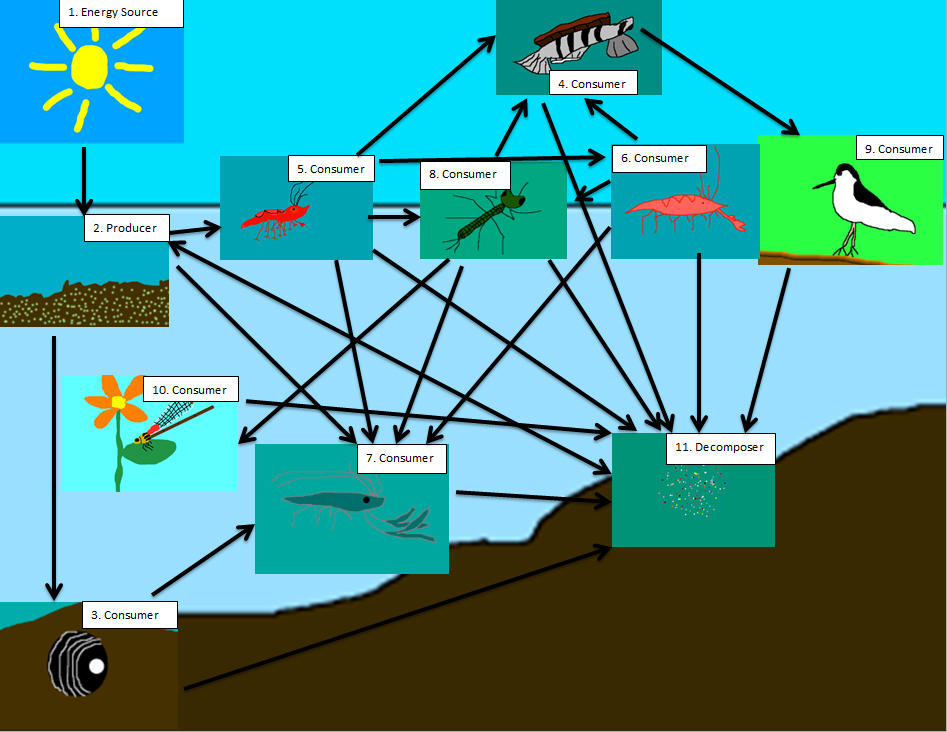Anchialine Pond Food Web
Hawaii's anchialine ponds contain a large variety of organisms. Not all ponds have the same animals. Each location can have some or all of the organism from the food web below.
1. Energy Source - Sun The sun is the beginning of every food chain. It is a big star. It gives off heat. It keeps us warm.
2. Producer - Algae: The algae is the first source of food in this food chain. It takes in sunlight and creates food for their self.
3. Consumer - Pipipi: The pipipi is a type of water snail. It eats algae. It has a striped shell.
4. Consumer - O`opu: The o`opu is a fish that can go in and out of water. It is striped.
5. Consumer - Opae`ula: The opae`ula are tiny red shrimp. Opae means shrimp and ula means red.
6. Consumer - Metabetaeus lohena: This guy is like a bigger, badder opae`ula. It is hard to raise in captivity.
7. Consumer - Macrobrachium grandimanus: He is a shrimp with one big claw.
8. Consumer - Nymph: A nymph becomes a damselfly. It lives in the water.
9. Consumer - ‘Auku‘u (Black Crowned Night Heron /Nycticorax nycticorax hoactli): This bird spears fish and crustaceans with its beak. It is black and white like the clouds and the night. That is probably how it got its name. There is more black than white.
10. Consumer - Damselfly: It eats other insects. When you take a first glance at this creature, you may think it of a dragonfly. It looks like one, is colored like one, but is it one? Below is a table showing the differences between a damselfly and dragonfly.
11. Decomposer - Bacteria The bacteria breaks down plant matter and carcasses.
2. Producer - Algae: The algae is the first source of food in this food chain. It takes in sunlight and creates food for their self.
3. Consumer - Pipipi: The pipipi is a type of water snail. It eats algae. It has a striped shell.
4. Consumer - O`opu: The o`opu is a fish that can go in and out of water. It is striped.
5. Consumer - Opae`ula: The opae`ula are tiny red shrimp. Opae means shrimp and ula means red.
6. Consumer - Metabetaeus lohena: This guy is like a bigger, badder opae`ula. It is hard to raise in captivity.
7. Consumer - Macrobrachium grandimanus: He is a shrimp with one big claw.
8. Consumer - Nymph: A nymph becomes a damselfly. It lives in the water.
9. Consumer - ‘Auku‘u (Black Crowned Night Heron /Nycticorax nycticorax hoactli): This bird spears fish and crustaceans with its beak. It is black and white like the clouds and the night. That is probably how it got its name. There is more black than white.
10. Consumer - Damselfly: It eats other insects. When you take a first glance at this creature, you may think it of a dragonfly. It looks like one, is colored like one, but is it one? Below is a table showing the differences between a damselfly and dragonfly.
11. Decomposer - Bacteria The bacteria breaks down plant matter and carcasses.
CharacteristicsEyes
Body
Wing Shape
Position at Rest
Larvae
|
Dragonflytouch;are at the top of their head
stocky
different wing pairs, with hind wings broader at the base
wings held open, horizontally or downwards
breathe through rectal tracheal gills; stocky bodies
|
Damselflyseparated;on each side of head
long and slender
all wings similar in shape
wings held closed, over abdomen
breathe through caudal gills; slender bodies
|
by Reina Gr. 4

